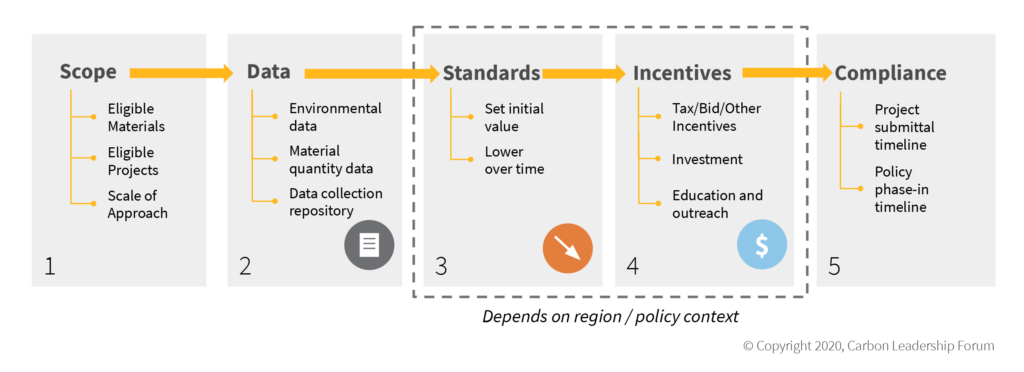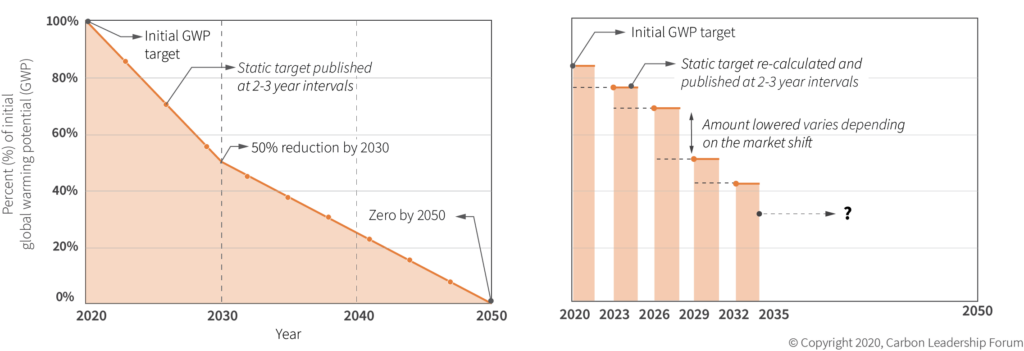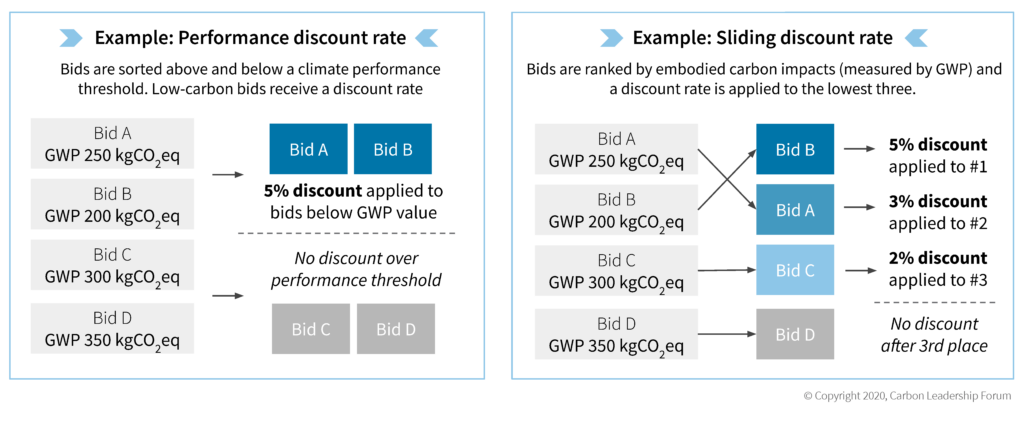This resource provides an overview of the five basic components of Buy Clean and highlights key choices at each step.
Version: December 17, 2020
Key Components of Buy Clean
An embodied carbon procurement policy, also commonly referred to as a ‘Buy Clean’ policy after California’s bill passed in 2017, is composed of three to five essential components that answer the following questions:
- Scope: Which materials and projects are impacted by the policy? Under which government agency?
- Data: What type of environmental and project data must be submitted to comply with the policy?
- Standards [optional]: Do materials or projects need to be below a global warming potential (GWP)?
- Incentives [optional]: Is there financial and educational support available for manufacturers and/or companies that comply with the policy?
- Compliance: What is the timeline for submittal and for implementation of each component of the policy?
To learn more about each of the steps, see Figure 1 and follow the five-step guide provided in this primer.
Buy Clean legislation varies widely depending on its geographic and political context. Geographically, the carbon footprint of materials and availability of embodied carbon disclosure data varies widely due primarily to the carbon intensity of the energy available in the region (for local products); and the quantity of environmental product declarations (EPDs) available in the region to set global warming potential (GWP) standards. GWP targets are measured in kilograms of carbon dioxide equivalents (kg CO2eq) per functional unit of product. See Embodied Carbon 101 for additional guidance.
City, state, and federal agencies can all implement Buy Clean type procurement policies, but they all have different project types, purchasing power, incentive levers, and environmental data availability that will influence the scope of policy. A federal Buy Clean program may have more funding available to incentivize research, whereas a state Buy Clean program may be able to set regionally appropriate GWP targets earlier.
For additional reference, see the primer What is Buy Clean Policy? and/or the full policy evaluation in the 2019 Buy Clean Washington Study.

Figure 1. Overview of five key components of Buy Clean.
Step 1 – Establish Policy Scope
1.1
Eligible materials
Which materials will be covered by the policy? (select a subset of building materials targeting a specific segment of the industry, such as:)
❒ 1. Major structural materials, including concrete, steel, and wood
❒ 2. Potentially high-impact architectural materials and finishes, including aluminum, glass, insulation, ceiling tile, gypsum board, and flooring materials
❒ 3. Civil materials, including asphalt pavement, concrete, and steel
❒ 4. High-impact trade-exposed materials
 Additional considerations: Material descriptions
Additional considerations: Material descriptions 
Naming terminology for materials should be aligned with industry terminology to clearly communicate the scope to contractors, engineers, architects, and manufacturers. Policymakers can ensure clear communication of the scope by:
- Engaging the local AEC community to review material descriptions for clarity
- Adopting the naming terminology in the Embodied Carbon in Construction Calculator (EC3) which was developed in collaboration with trade associations for each material
1.2
Eligible projects
Which types of projects will be covered by the policy? (select one option)
❒ 1. All construction projects, including buildings and transportation*
❒ 2. Certain projects, as defined by an area threshold (i.e. ‘projects greater than 20,000 square feet’) or a budget threshold (i.e. ‘projects with a budget greater than one million USD’)
*Note: Buy Clean legislation should identify the government agencies with eligible projects. These agencies vary by region, but examples of key agencies include departments of transportation and state universities.
 Additional considerations: Project size
Additional considerations: Project size 
Requiring all construction projects guarantees the broadest impact. However, project size is typically related to the size of the firm working on the project. Setting an area or budget threshold may help reduce the likelihood that small businesses without resources to dedicate to training related to low-carbon procurement would be at a disadvantage.
1.3
Scale of approach
Will the policy be focused on the materials only (material-scale), or will it consider the overall environmental impact of the project (building-scale) in addition to materials?
❒ 1. Material-scale
❒ 2. Material- and building-scale
 Additional considerations: Scale
Additional considerations: Scale 
Material-scale policies are less complex and therefore easier to implement than building-scale policies. They focus on transitioning to clean manufacturing. Building-scale policies are more complex, but promote broader embodied carbon reduction strategies that can result in bigger carbon reductions, such as material efficiency and reuse of buildings or materials.


